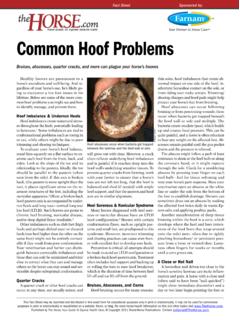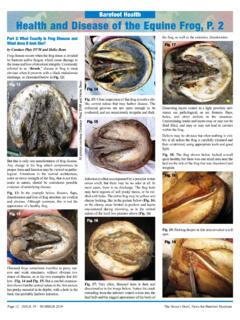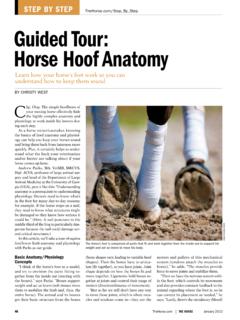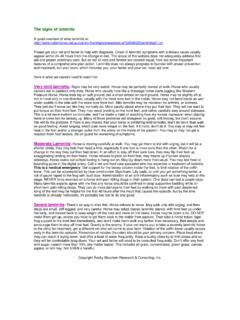Transcription of Time for Technology - DairyLogix
1 time for Technology Feed-Stalls and Tube Systems Offer New Solutions to Alley Scraper Woes Jack Rodenburg, DairyLogix hoof care specialist Dr. Gerard Cramer, speaking at the Western Dairy Seminar last March, condemned alley scrapers because he and commercial hoof trimmers he works with, consistently see the most foot problems in barns with mechanical scrapers. While I don t doubt their observations, for the smaller freestall dairy, these scrapers are an important labour saving tool. But healthy feet are an important key to productivity and to low labour cow care, so if scrapers are linked to foot problems they either need to go or improvements need to be implemented. Fortunately there are solutions, and we need to get serious about adopting them. The only goal of removing manure from the alleys is to provide cows with a clean dry and comfortable place to walk in their freestall environment.
2 Slatted floors tend to be dry, and with the addition of slat scrapers, they can also be clean. But, given a choice, cows avoid walking on them, suggesting cow comfort is compromised. Slatted barns also cost more to build. Solid floors require regular scraping, and the labour of doing so, the degree to which it disturbs cows and the impact on foot health all become factors in the decision of how to do this. Traditional alley scrapers deserve their bad reputation because they are moving manure baths, that soak the feet of standing cows in manure on each pass through the barn. Wet dirty feet are much more prone to infection. Stepping over the scraper, especially at the feed manger is also a disturbance for cows and a source of injuries and trauma. On larger dairies, where milking always involves a team of people, assigning a person to tractor scrape the alleys while the cows are away for milking means scraping does not disturb the cows, and they are never exposed to more manure than what is evenly distributed over the floor.
3 Wide alleys and three times a day milking and scraping promote good foot health in this setting. Labour costs using big equipment and low paid staff that can combine this task with moving cows to the parlor can be kept in line, making this a practical choice for big herds. But on the family dairy, where one person may do the chores alone and where there are multiple groups and gates along the length of an alley, tractor scraping is more costly, and less convenient. In robotic milking barns where cows never leave, disrupting the cows by tractor scraping is not an option, and in these situations alley scrapers become a necessary evil . But foot health is important on smaller dairies too, and essential in robotic milking barns. Minimizing the evil involves minimizing the size of the shit bath . In existing barns, observing several complete passes of the scraper and counting the number of cows that get their feet dirty is one way to assess what impact the scraper has.
4 While there is no magic number, if more than 2% of cows experience the shit bath on a typical scraper run, this is likely a contributing factor to foot problems in the herd. Traditional ways to minimize the size of the bath include scraping more frequently resulting in more but smaller baths, and more disturbance for cows at the feed bunk. In my experience, running scrapers continuously generally improves cow cleanliness and foot health and may pay off despite the greater disturbance to the cows, greater chain or cable wear and higher electrical cost. Shorter scraper runs with a manure drop in the middle of the barn instead of at one end also reduces the size of the bath, as does wider alleys. V scrapers form a triangular bath, that allows cows to step over the corner without getting their feet dirty. Because they fold up on the return pass they are also less disturbing for the cows.
5 But these scrapers require more space at the ends of the barn and take longer to open, leaving a large corner dirty near the corner wheel. The overall dynamic of the barn itself is also a big factor. With enough comfortable stalls and cows resting in the stalls 14 hours per day few cows will be standing in the alley when the scraper comes through, and if there are enough stalls and crossovers a cow in the alley should be able to avoid the scraper by stepping into one of them. If barns are overcrowded or stalls are too small, more perching cows and more cows standing in the alleys can easily double the number of manure baths caused by the scraper. For new construction, two adaptations offer some interesting benefits. Feed-stalls at the manger, which consist of 50 inch long partitions perpendicular to the feed fence, spaced 35 inches apart, so that cows can only access the manger by walking into this protected stall.
6 Since cows do not back into these stalls there is no manure along the manger and by adding a slightly raised platform for the eating cow to stand on, the alley scraper can be configured so it runs behind this platform and does not pass under the cow at the manger. Research by Dr. Trevor DeVries demonstrated these stalls increase eating time and decreased the number of aggressive displacements at the manger. But they also provide the eating cow, and for that matter a cow stepping up to avoid the scraper, a cleaner drier place to stand. No studies have been done to assess the benefit to foot health of this innovation but I am willing to bet it is substantial. The second innovation that is becoming very popular south of the border is the tube scraper . I first saw this system in use at Mason Dixon Farms in Pennsylvania, in their first robotic milking barn built in 2005.
7 I recently visited four robotic dairies in New York State. Three had chosen for this type of scraper and all three were very happy with the results. The tube system consists of a precast concrete tube with a continuous narrow neck and slot opening in the top. This tube is placed on a footing below the floor of the alley, which is backfilled with gravel. The floor is poured on top so that it butts up to the gap on both sides with about 1 inch of slope from the curb down toward the gap. The tube opens into the cross gutter below the spot where the scraper drops its manure. The scraper consists of a standard V or winged plough running on top of the floor, with a hinged paddle attached to the bottom of the plough. The slope on the floor means that most manure liquids run directly into the trench, keeping the floor much drier.
8 On each pass, the plough draws the manure to the centre, where most of it drops down into the trench, so there is never a bath of manure in front of the scraper. The paddle cleans the trench and flips up at the hinge on the return pass. These scrapers have also been adapted to clean in both directions, resulting in a cleaner barn with fewer passes. As an added bonus, cable wear is dramatically reduced because the cable is suspended in the trench instead of running over the concrete floor. Despite some very long scraper runs in the New York barns I visited, the cows feet were clean and at no time was there a build up of manure ahead of the scraper. With the continuous opening in the top, this tube requires a lot of reinforcement resulting in a substantial cost for the material and installation. At roughly $65 per running foot installed, a 200 foot long 200 cow 6 row barn will cost about $50,000 more with a tube scraper than a conventional alley scraper system.
9 Although a few more years experience will tell the tale, dairymen working with these systems are now are convinced the extra cost is justified. If a dairyman were to include both the tube scraper and feed-stalls, construction costs would be about $350 per cow higher than conventional designs. At 5% interest over 20 years, that is roughly 7 cents per cow per day. Dr. Cramer reports that the prevalence of clinical lameness is 20 to 30%. He also found that hoof trimmers report lesions in 40 to 70% of cows. While we don t know how much we can improve on this now, I hope that in a few years, Dr. Cramer and Ontario hoof trimmers will tell us foot health and alley scrapers done right, can go hand in hand after all. A Norbco tube scraper at Post Dairy in New York State. Note there is very little manure in front of the scraper as it approaches the end of this 340 foot long alley in this 3 robot sand bedded barn.
10 End view of the tube and paddle of a Jamesway tube scraper system. Feed-stalls and the original tube scraper system at Mason Dixon Dairy, in Pennsylvania. The Waybright family. owners of this dairy are well known for their innovative ideas.






